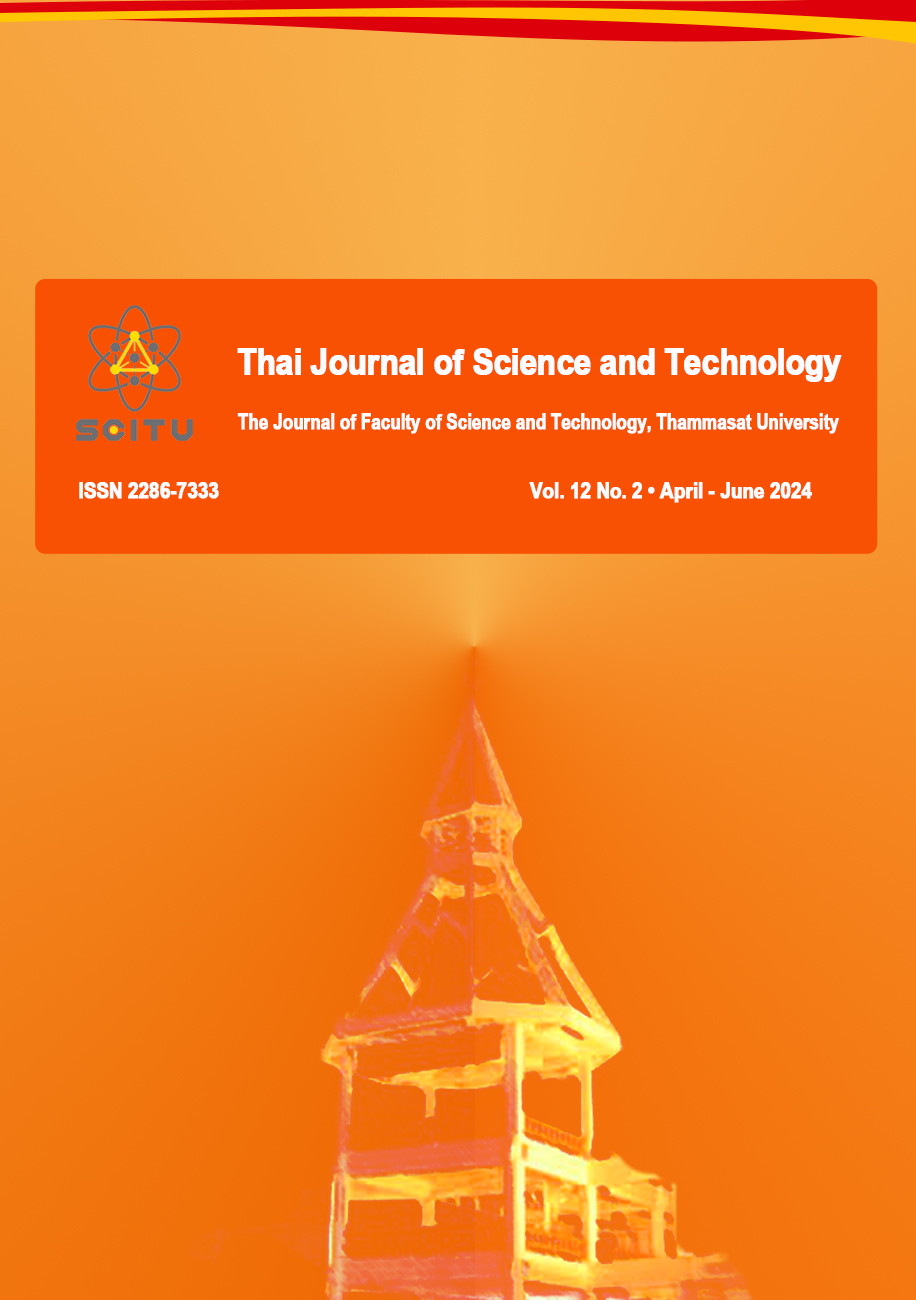Economic Feasibility and Greenhouse Gas Reduction Analysis of Installing a Solar Rooftops on Dormitory Buildings at Thammasat University, Rangsit Campus
Main Article Content
Abstract
Solar energy is an environmentally friendly energy that supports Thailand's goal of achieving carbon neutrality. This study analyzed the economic feasibility of installing rooftop solar photovoltaic (PV) systems on dormitory buildings at Thammasat University Rangsit Center to reduce electricity consumption from the grid. The results show that the optimal installed capacity is 1.4 MWp, which can generate approximately 1,881,337 kWh/year, equivalent to a reduction in greenhouse gas emissions of 914 tCO2e/year. The economic feasibility analysis shows that the project is economically viable. The levelized cost of electricity (LCOE) is between 2.34 and 2.68 baht/kWh, and the internal rate of return (IRR) is between 15.35% and 18.45%. The payback period is approximately 5-6 years. A sensitivity analysis was conducted considering the following factors: (1) self-consumption ratio, (2) solar cell degradation rate, and (3) operating and maintenance cost. The results show that the self-consumption ratio is the most critical factor affecting the project's viability. The project is viable only if the self-consumption ratio is higher than 60%. The other two factors do not significantly affect the project's viability.
Article Details

This work is licensed under a Creative Commons Attribution-NonCommercial-NoDerivatives 4.0 International License.
บทความที่ได้รับการตีพิมพ์เป็นลิขสิทธิ์ของคณะวิทยาศาสตร์และเทคโนโลยี มหาวิทยาลัยธรรมศาสตร์ ข้อความที่ปรากฏในแต่ละเรื่องของวารสารเล่มนี้เป็นเพียงความเห็นส่วนตัวของผู้เขียน ไม่มีความเกี่ยวข้องกับคณะวิทยาศาสตร์และเทคโนโลยี หรือคณาจารย์ท่านอื่นในมหาวิทยาลัยธรรมศาสตร์ ผู้เขียนต้องยืนยันว่าความรับผิดชอบต่อทุกข้อความที่นำเสนอไว้ในบทความของตน หากมีข้อผิดพลาดหรือความไม่ถูกต้องใด ๆ
References
Abdallah, R., Juaidi, A., Salameh, T., Jeguirim, M., Çamur, H., Kassem, Y., & Abdala, S. (2022). Chapter 1 - Estimation of solar irradiation and optimum tilt angles for south-facing surfaces in the United Arab Emirates: a case study using PVGIS and PVWatts’, in M., Jeguirim (ed.) Recent Advances in Renewable Energy Technologies. Location: Academic Press, 3-39.
Andy, W., Lockhart, E., Desai, J., Ardani, K., Klise, G., Lavrova, O., Tansy, T., Deot, J., Fox, B., & Pochiraju, A. (2020). Model of Operation-and-Maintenance Costs for Photovoltaic Systems. Golden, CO: National Renewable Energy Laboratory. NREL/TP-5C00-74840. Retrieved from https://www.nrel.gov/docs/fy20osti/ 74840.pdf.
Bank of Thailand. (2024a). Macroeconomic Indicators. Retrieved from app.bot.or.th/BTWS_STAT/ statistics/ BOTWEBSTAT.aspx?reportID=409&language=TH. January 30, 2024. (in Thai)
Bank of Thailand. (2024b). Loan Interest Rate. Retrieved from https://www.bot.or.th/th/statistics/ interest-rate.html. January 30, 2024.
Department of Alternative Energy Development and Efficiency, Ministry of Energy. (2017). Project to Improve the Solar Potential Map from Satellite Images for Thailand. Retrieved from https://oldwww.dede.go.th/ewt_news.php?nid=47736&filename=index. January 20, 2024. (in Thai)
Energy Policy and Planning Office, Ministry of Energy. (2023). Thailand Energy Statistics Report 2023, pp 177-178. Retrieved from https://www.eppo.go.th/index.php/th/component/k2/item/19566-energy-statistics-2566. January 20, 2024. (in Thai)
Global Compact Network Thailand. (2021). Thailand's Long-term Greenhouse Gas Emission Development Strategy, presented at COP26, Thailand Pavilion Retrieved from globalcompact-th.com/news/detail/602. January 20, 2024. (in Thai)
Hadj Arab, A., Taghezouit, B., Abdeladim, K., Semaoui, S., Razagui, A., Gherbi, A., Boulahchiche, S., & Hadj Mahammed, I. (2020). Maximum power output performance modeling of solar photovoltaic modules. Energy Reports, 6(1), 680-686.
International Renewable Energy Agency. (2023). Renewable Power Generation Costs in 2022 (p. 207). Retrieved from www.irena.org/Publications/2023/Aug/Renewable-Power-Generation-Costs-in-2022
Jordan, D.C., Smith, R.M., Osterwald, C.R., Gelak, E. & Kurtz, S.R. (2011). Outdoor PV Degradation Comparison, NREL/CP-5200-47704. 7pp.
Jordan, D.C., & Kurtz, S.R. (2012). Photovoltaic Degradation Rates: An Analytical Review (NREL/JA-5200-51664). 30pp.
Koner, P.K., Dutta, V., & Chopra, K.L. (2000). A comparative life cycle energy cost analysis of photovoltaic and fuel generator for load shedding application. Solar Energy Materials and Solar Cells, 60(4), 309-322.
Limmanee, A., Udomdachanut, N., Songtrai, S., Kaewniyompanit, A., Sato, Y., Nakaishi, M., Kittisontirak, S., Sriprapha, K., & Sakamoto, Y. (2016). Field performance and degradation rates of different types of photovoltaic modules: A case study in Thailand. Renewable Energy, 89, 12-17.
Office of the National Economic and Social Development Council. (2023). Thirteenth National Economic and Social Development Plan (2023-2027). Retrieved from https://www.nesdc.go.th/main.php?filename=plan13. January 20, 2024. (in Thai)
Solarpraxis, A.G. (2011). Inverter and PV System Technology Industry Guide 2011 (RENI-Renewable Insight Energy Industry Guides, p. 98).
Thailand Greenhouse gas Management Organization (TGO). (2023a). Electricity Generation from Renewable Energy (T-VER-S-METH-01-01). Retrieved from https://ghgreduction.tgo.or.th/th/tver-method/t-ver-classify-methodology/t-ver-methodology1/item/3554-electricity-generation-from-renewable-energy.html (in Thai)
Thailand Greenhouse gas Management Organization (TGO). 2023b. Greenhouse Gas Emission Values from Electricity Generation and Consumption for Greenhouse Gas Reduction Projects and Activities. Retrievd from https://ghgreduction.tgo.or.th/th/download-tver/120-tver-gwp-emission-factor/3377-emission-factor-30-2565.html (in Thai)
United Nations Framework Convention on Climate Change (UNFCCC). (2014). AMS-I.D.: Grid Connected Renewable Electricity Generation. Retrieved from https://cdm.unfccc.int/methodologies/DB/W3TINZ7KKWCK7L8WTXFQQOFQQH4SBK
United Nations Framework Convention on Climate Change (UNFCCC). (2016). ACM0002 Grid-Connected Electricity Generation from Renewable Sources Version 17.0, Available Source: http:// cdm.unfccc.int/methodologies/DB/8W400U6E7LFHHYH2C4JR1RJWWO4PVN.


